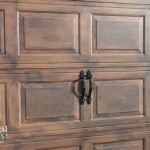Revamp Your Garage With Gel Stain On Wood
The garage, often relegated to a storage space for vehicles and assorted items, can be transformed into a functional and aesthetically pleasing area. An economical and effective method for achieving this transformation involves the application of gel stain on the existing wooden surfaces within the garage. Gel stain offers a unique approach to wood finishing, providing both color and protection to garage doors, workbenches, shelving, and other wooden elements.
Unlike traditional wood stains, gel stain possesses a thicker consistency. This characteristic allows it to adhere exceptionally well to various surfaces, including wood, veneer, fiberglass, and even metal. The gel-like texture minimizes drips and runs during application, making it a user-friendly option for both seasoned DIY enthusiasts and those new to woodworking projects.
The garage environment presents unique challenges to wood finishes. Fluctuations in temperature and humidity, coupled with the potential for exposure to automotive fluids and other chemicals, can degrade traditional finishes over time. Gel stain, generally formulated with a higher solids content than liquid stains, provides a robust barrier against these elements, enhancing the longevity of the treated wood.
Understanding the Advantages of Gel Stain for Garage Wood
Gel stain offers a multitude of benefits that make it a particularly suitable choice for revitalizing wooden surfaces within a garage. These advantages extend beyond mere aesthetics, encompassing durability, ease of use, and versatility.
One of the primary advantages of gel stain is its superior adhesion. Traditional stains may struggle to penetrate certain types of wood or pre-existing finishes. Gel stain, with its thicker consistency, clings to the surface and effectively imparts color, even on non-porous or previously finished materials. This quality is particularly valuable in situations where stripping the existing finish is impractical or undesirable.
The ease of application is another key benefit. Its non-drip formula simplifies the staining process, reducing the likelihood of mistakes and ensuring a more uniform finish. This is especially beneficial when working on vertical surfaces, such as garage doors or shelving units. The slower drying time also allows for more control during application, enabling the user to achieve the desired color intensity without rushed work.
Furthermore, gel stain offers excellent color retention. The pigments used in gel stains are often more concentrated than those found in traditional stains, leading to richer, more vibrant colors that resist fading over time. This is crucial in a garage environment where exposure to sunlight and artificial lighting can contribute to the degradation of color in less durable finishes.
The inherent durability of gel stain is a significant factor in its suitability for garage applications. It forms a protective layer that resists scratches, scuffs, and minor impacts. The barrier it creates also helps to protect the wood from moisture damage and chemical spills, common occurrences in a garage setting. This increased resistance to wear and tear translates into a longer lifespan for the finished wood surfaces, reducing the need for frequent refinishing.
Preparing Wooden Surfaces for Gel Stain Application
Proper preparation is paramount to achieving a professional-looking and long-lasting finish with gel stain. The steps involved in surface preparation may vary depending on the condition of the wood and the type of existing finish, but the underlying principles remain consistent.
The first step is to thoroughly clean the wooden surface. This involves removing any dirt, dust, grease, or other contaminants that could impede the adhesion of the gel stain. A mild detergent and water solution can be used for general cleaning, followed by a thorough rinsing and drying. For stubborn grease or oil stains, a specialized degreaser may be necessary.
Next, inspect the wood for any imperfections, such as scratches, dents, or gouges. These blemishes should be addressed prior to applying the gel stain. Small scratches can often be sanded smooth using fine-grit sandpaper. Deeper imperfections may require the use of wood filler or patching compound. Once the filler has dried completely, it should be sanded flush with the surrounding surface.
If the wood has an existing finish, it's important to assess its condition. If the existing finish is in good condition and is compatible with gel stain, it may simply be scuff-sanded to provide a better surface for adhesion. Scuff-sanding involves lightly sanding the surface with fine-grit sandpaper to create microscopic scratches that improve the bond between the existing finish and the gel stain.
If the existing finish is peeling, cracking, or otherwise damaged, it should be removed completely. Various methods can be used to remove old finishes, including chemical strippers, sanding, or scraping. The choice of method will depend on the type of finish and the condition of the wood. After removing the old finish, the wood should be thoroughly cleaned and sanded to create a smooth, even surface.
Before applying the gel stain, it may be beneficial to test a small, inconspicuous area to ensure compatibility and to verify that the desired color is achieved. This test spot will allow the user to assess the appearance of the stain on the specific type of wood and to make any necessary adjustments to the application technique.
Finally, wipe the surface with a tack cloth to remove any remaining dust particles before beginning the staining process. A clean, dust-free surface is essential for achieving a smooth, even finish.
Applying Gel Stain for Optimal Results
The application of gel stain requires a careful and methodical approach to ensure a consistent and aesthetically pleasing result. While the process is relatively straightforward, attention to detail is crucial for achieving professional-quality results.
The first step is to stir the gel stain thoroughly to ensure that the pigments are evenly dispersed. Unlike traditional stains, gel stain should not be shaken, as this can introduce air bubbles that can affect the final finish. Use a stir stick to gently mix the stain until it is a uniform color and consistency.
Apply the gel stain in thin, even coats using a lint-free cloth, foam brush, or bristle brush specifically designed for gel stains. Work in small sections, following the grain of the wood. Avoid applying too much stain at once, as this can lead to drips and uneven coverage. It is generally preferable to apply multiple thin coats than one thick coat.
After applying the stain, allow it to sit on the surface for a few minutes to allow the pigments to penetrate the wood. The exact dwell time will depend on the desired color intensity and the type of wood being stained. Refer to the manufacturer's instructions for specific recommendations.
Once the stain has had sufficient time to dwell, wipe off the excess stain with a clean, lint-free cloth. Use a wiping motion that follows the grain of the wood. Be sure to remove all excess stain, as any remaining stain will become sticky and uneven as it dries. The amount of stain removed will determine the final color intensity.
Allow the first coat of gel stain to dry completely before applying a second coat, if desired. The drying time will vary depending on the temperature, humidity, and the type of gel stain used. Refer to the manufacturer's instructions for specific drying time recommendations. A second coat can deepen the color and provide additional protection.
After the final coat of gel stain has dried completely, apply a clear topcoat to protect the finish and enhance its durability. A polyurethane or varnish topcoat is generally recommended for garage applications, as these finishes are resistant to moisture, chemicals, and abrasion. Apply the topcoat in thin, even coats, following the manufacturer's instructions. Allow the topcoat to dry completely before using the stained wood surfaces.
Proper ventilation is essential during the application of gel stain and topcoat. Work in a well-ventilated area or use a respirator to avoid inhaling harmful fumes. Dispose of used rags and brushes properly to prevent spontaneous combustion.
By following these steps carefully, individuals can effectively utilize gel stain to transform the appearance and durability of wooden surfaces within their garage, creating a more functional and visually appealing space.

Diy Garage Door Makeover With Stain Domestically Speaking

Diy Garage Door Makeover With Stain Domestically Speaking

Diy Gel Stain Garage Door Update Domestically Speaking

Diy Garage Door Makeover With Stain Domestically Speaking

Gel Stain Garage Doors To Revitalize Them Our Recipes For Success

Gel Stain Garage Door Refinish Crochet It Creations

Revamp Those Garage Doors Faux Wood Door Diy

Diy Garage Door Makeover With Stain Domestically Speaking

Refresh Old Wood Easily Garage Door Update Prodigal Pieces

Create A Faux Wood Garage Door With Gel Stain Crazy Life Littles
Related Posts








